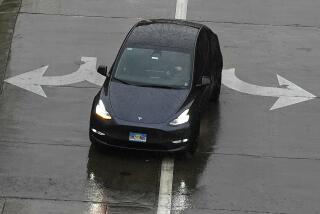Old-Car Owners Left in Lurch
Calling it a “win-win situation,” Gov. Gray Davis last year praised a popular program that paid motorists $1,000 to turn their smog-spewing old clunkers into scrap metal.
The only problem was that Davis had pulled the plug on the initiative a month before he touted it--part of nearly $3 billion in cuts to address the state’s budget crisis.
Davis’ elimination of the vehicle retirement program that he himself boosted has surprised and angered environmentalists. It also leaves in the lurch about 7,000 Californians who applied for the money. Instead, they will be getting notices in the next few weeks telling them the program has been axed.
The program, run by the Bureau of Automotive Repair, made $1,000 payments to Californians who turned in cars that failed smog checks. Since the program’s inception in July 2000, more than 30,000 cars and trucks have been sent to auto dismantlers for destruction.
The auto-scrapping program was among at least 80 initiatives cut or frozen under a Davis budget relief plan released in November. The plan was approved by state lawmakers earlier this month.
Chandrashekhar Mahatme, an engineer from the San Francisco Bay Area community of Cupertino, is one of those thousands of motorists who have yet to hear what will happen to their applications. He filed in September to junk his 1984 Honda Civic.
He called the state Bureau of Auto Repair in December and was told his application was approved. But since then, Mahatme said, he has received no confirmation letter or information about where to take his car.
For now, the Honda sits in the parking lot of his apartment building, collecting dust and irritating his landlord. Mahatme said the clunker is not worth the $500 in repairs needed to pass the smog check.
“It’s a big problem because I don’t know what to do with it,” he said. “It’s not worth repairing.”
A spokeswoman for Davis said the governor touted the program in December--even after his office moved to kill it--because he was proud of its success. Removing old cars from the road reduced pollutants in the air by an estimated 8,500 tons annually.
Davis spokeswoman Hilary McLean insisted that the governor did not send a mixed message by praising the program.
“We still support the spirit of the program and the merits,” she said. “It’s never a fun position to be in, to reduce funds in a program you care about.”
McLean noted that motorists can still apply to the Department of Consumer Affairs for grants of up to $500 to make emission-related repairs.
Still, the reaction to the program’s demise has been sharp.
In the last few days, the state Bureau of Auto Repair has received more than 500 calls a day from motorists asking what became of the program, according to state officials.
The Department of Consumer Affairs has also received about 300 calls a day from frustrated vehicle owners, said Glen Mason, a department spokesman.
“We are disappointed too,” he said, “because it was a great program.”
State’s Goal Met in Year and a Half
Mason noted that the state set a goal of scrapping or repairing 50,000 emission-violating cars and trucks within four years. With 30,000 cars scrapped and an additional 20,000 repaired, the state met that goal in only a year and a half, he said.
Environmental groups are also upset by the program’s demise, saying it was a key element in the California’s efforts to reduce harmful smog levels.
“This will put a hole in the state’s pollution-control program,” said Gail Ruderman Feuer, senior attorney for the Natural Resources Defense Council in Los Angeles.
She said her group plans to press the governor to restore the funding or create another smog-cutting initiative.
“If the governor plans to remove it, he has to come up with a way to fill in for that,” Feuer said.
Tim Carmichael, director of the Coalition for Clean Air in Los Angeles, said he learned of Davis’ decision after a confused motorist called his organization last month to ask about the status of the auto-scrapping program.
Carmichael credits the program for putting thousands of smog-spewing cars out of commission. But he noted that an estimated 2 million to 3 million other smog violators are still on the road today.
Local air quality regulators, such as the South Coast Air Quality District, run similar vehicle-crushing programs.
Those programs are funded by businesses that need “smog credits” in order to meet state emissions standards. But such programs typically pay about half the amount that was offered by the state program.







